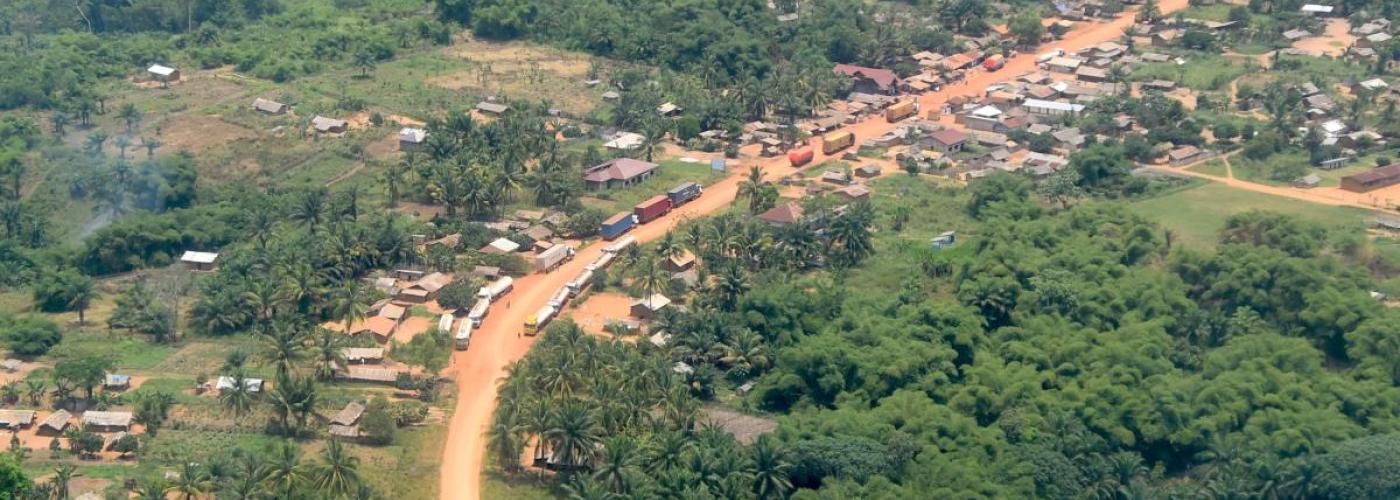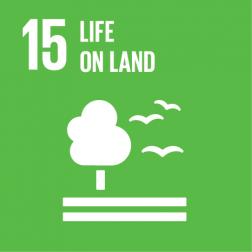Tropical rainforests store massive amounts of CO2, one of the main greenhouse gases. As a result, they significantly mitigate climate disruption. And that certainly includes the rainforest in the Congo River Basin. Current research by Ghent University and the AfricaMuseum in the Yangambi Reserve, not far from Kisangani (DR Congo), even suggests that the Congolese rainforest absorbs almost 2 times more CO2 per hectare than the Amazon forest in South America. It is, therefore, vital to protect this rainforest as effectively as possible.
'But you can only protect a forest if biodiversity is also protected,' Hilde Keunen stresses. 'All the various animals and plants are needed to maintain a forest. Climate and biodiversity go hand in hand.' Keunen is a collaborator with CEBioS, a programme funded by the Belgian Development Cooperation and part of the Royal Belgian Institute of Natural Sciences (RBINS), better known as the Museum of Dinosaurs in Brussels.
Handful of people to write reports
For many years CEBioS - short for Capacities for Biodiversity and Sustainable Development - has been committed to assisting Belgian partner countries in implementing their commitments under the UN Convention on Biological Diversity (CBD). It focuses mainly on DR Congo, Burundi and Benin.
At the end of last year, the CBD realised an unexpectedly ambitious UN biodiversity framework. Almost the entire world agreed to protect 30% of all land and oceans by 2030. However, for a gigantic country like DR Congo with super-rich biodiversity, it is not easy to meet all the obligations that arise from such UN agreements. 'Think only of the various reports that have to be written,' Keunen says. 'The Congolese government only has a handful of people for that job!'
Science-policy interface: bringing research and policy together
'CEBioS has already done a lot of work in this area,' she clarifies. 'With few resources and many contacts all over the country, we tried to set up a system that could help the national ministry with obligations around CBD. In the jargon one talks about the ‘science-policy interface’: everything that needs to be done to translate the results of scientific research into policy. We were looking for ways to bring researchers and policymakers into regular contact with each other in order to foster mutual understanding. And that seems to be working pretty well.'
A dynamic science-policy interface is crucial to making informed policy decisions. 'For example, the Congolese government may decide to protect a percentage of the forest. But which areas are most worthy of protection? For that, you first need to know what biodiversity is out there!'

The active participation of Congolese environment minister Ève Bazaiba contributed greatly to the allure of the congress. ©CEBioS
A centre for policy support research in Kisangani
In Congo, much attention is focused on the Centre de Surveillance de la Biodiversité (CSB), housed at the University of Kisangani (UNIKIS). Keunen adds, 'The CSB was established in the aftermath of the major biodiversity expedition along the Congo River in 2010 and was intended to preserve and study the resulting collections. Besides ourselves, also the AfricaMuseum and the Meise Botanical Garden were involved. Ideally, the CSB should become the key player in terms of the science-policy interface around biodiversity in Congo. In Burundi, we are doing something similar with the Office Burundais pour la Protection de l'Environnement (OBPE).'
CSB, along with its network, must become strong in policy supporting research. As a model to be pursued, Hilde Keunen mentions the Research Institute for Nature and Forest (INBO) in Flanders. After all, INBO profiles itself as an 'independent research institute of the Flemish government that underpins and evaluates biodiversity policy and management through applied scientific research, data and knowledge disclosure.'
'To help them to take on that role, we do many small things,' Keunen says. 'This includes a lot of training. But not necessarily by us. We are striving to encourage South-South cooperation as much as possible. Therefore, it is often experts from the South who provide the training. Like a Beninese who talked about managing data files.'
A large, accessible conference in a local setting
The recent organisation of a biodiversity conference at UNIKIS also fell within that framework. In order to grow, scientists need to meet and exchange experiences. 'But that is extremely difficult for scientists from the Congo Basin,' Keunen says. 'International conferences are often organised elsewhere in the world and are therefore too expensive for them.'
This is why, back in 2014, BELSPO (PPS Science Policy) and the CSB decided to organise the first international scientific conference on biodiversity in the Congo Basin in their own environment, at UNIKIS, in the heart of the Congo Basin. The university is also near the previously mentioned Yangambi Nature Reserve, established in 1939 and recognised by UNESCO as a 'biosphere reserve' in 1977.
From 6 to 10 March 2023, CEBioS and CSB organised a second conference, this time on a larger scale and largely funded by the Belgian Development Cooperation. 'We received more than 600 registrations of which 320 people attended in person. Most were from the Congo Basin. There were over 200 Congolese, in addition to researchers from Cameroon, Burundi, Benin, Uganda and Rwanda. In addition, of course, many Belgians, but also Dutch, Swedes and Germans participated in the event. People from the United Nations Environment Programme (UNEP) and the international institution CIFOR, which specialises in forest research, also took part.'
Organising this type of event in a hard-to-reach location in Congo was no mean feat. But, amazingly, it all fell into place. Fortunately, CEBioS could rely on a solid Congolese network as well as a local team of 80 to 90 people. 'In fact, just developing expertise in terms of organising a high-level conference was a great result!' explains Keunen.
Active presence of the Congolese Environment Minister
The conference was very animated and there were plenty of opportunities for networking and interaction. It encompassed highly regarded keynote speakers, various workshops, an exhibition area with booths, and posters allowing a range of nature parks, among others, to present themselves. Short documentaries, which had been submitted for a competition, were played continuously too. For another contest, secondary schools were asked to submit essays and primary schools could submit drawings, all on the theme of biodiversity. So the impact went beyond mere scientists and policymakers.
'What certainly also contributed to the allure of the conference was the active presence of Congolese Environment Minister Ève Bazaiba,' says Keunen. 'She was the last person to stand firm on the Montreal biodiversity agreement because of dissatisfaction with funding. She provided an excellent talk, was actively engaged, participated in workshops and so on.'
A few of the Congolese delegation that negotiated at COP15 in Montreal were also there, in addition to some members of the Belgian delegation. 'They explained exactly how these negotiations work. As such, they imparted the sense that all participants were part of a bigger picture.'

The conference was well attended. ©CEBioS
Forest management by local community offers way out
Topics covered ranged from more scientific matters such as taxonomy and primates to practical aspects such as forest protection and community forestry. Congo is pushing very hard on the latter to protect its forests.
'The major threat to forests is high population pressure,' Keunen explains. 'The people there live off the rainforest. Their houses are made of it, they use gourds as buckets, they cook on wood they cut down in the forest, and they hunt game. They also need places to live and, for their agriculture, they rely on the slash-and-burn approach. They burn down a section of forest and turn it into agricultural land. When that area is exhausted, they burn another one to grow new plants, and so it continues. The more the population increases, the greater the pressure on the rainforest.'
Community forestry offers a way out. This means that although a community or village may exploit a piece of forest, this may only be done within certain boundaries, i.e. without fundamentally affecting the forest and its biodiversity. That works well but requires very good agreements, Keunen argues. 'There should be experts living in the villages or visiting on a regular basis to demonstrate how things can be done differently. People don't always understand it well and need concrete examples.'
A successful conference with greatly satisfied participants
In short, CEBioS - in addition to Hilde Keunen, coordinator Luc Janssens de Bisthoven and senior researcher Erik Verheyen - can certainly look back on a successful conference, with greatly satisfied participants and plenty of opportunities for networking. On a side note, another great result was that the Swedes and Germans made good progress towards the formulation of major projects on biodiversity in Congo, thanks to the contacts made at the conference.
CEBioS is continuing on its chosen path; acting as a facilitator and providing frequent small nudges. In any case, Keunen notices that it’s producing results. Since 2010, the research has clearly evolved in a positive way while the authorities are more closely involved. These are all aspects that help protect the Congo Forest. Although there remains a long way to go.



